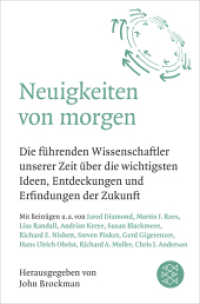Full Description
How can you use the latest digital technology to create an environment in which people can learn European languages while performing a meaningful real-world task and experiencing the cultural aspect of learning to cook European dishes? This book explains how to do this from A to Z, covering how a real-world digital environment for language learning was designed, built and researched.
The project makes language learning motivational and fun by tapping into people's interest in both cooking and technology - you can learn a language while cooking and interacting with a speaking digital kitchen. The kitchens provide spoken instructions in the foreign language on how to prepare European cuisine. Digital sensors are inserted in or attached to all the kitchen equipment and ingredients, so the digital kitchen detects what learners are doing and gives them feedback. Learners are also able to communicate with the kitchens and can ask for help via photos and videos if they don't understand any foreign language words.
Based on two research grants, the book provides five research studies showing the learning experiences of users in five European countries. The book explains the principles and procedures involved in the project, enabling others to design and implement a real-world digital learning environment in the same way. It includes numerous photographs of the system in use and evidence of how and what 250 users actually learnt.
Contents
List of Illustrations
Notes on Contributors
Acknowledgements
Transcription Conventions
PART I: BACKGROUND
1. Introduction, Paul Seedhouse (Newcastle University, UK)
2. Locating the European Digital Kitchen in its research context, Sandra Morales Rios (Newcastle University, UK)
PART II: DESIGN
3. The Pedagogical Design of the Digital Kitchen, Paul Seedhouse (Newcastle University, UK)
4. The Technology behind the Digital Kitchen for Language Learning, Paul Seedhouse (Newcastle University, UK)
5. The Human Viewpoint and the System's Viewpoint, Gabriele Pallotti and Natacha Niemants. (University of Reggio Emilia, Italy)
PART III: IMPLEMENTATION
6. Assessing and promoting language development in an interactive learning environment, Jana Roos, Nina Reshöft, Lea Hartung and Johanna Bußwinkel (Paderborn University, Germany)
7. Cooking, Interaction and Learning: the Finnish Digital Kitchen as a Language Learning Environment, Salla Kurhila and Lari Kotilainen (University of Helsinki, Finland)
8. "The more I cook, the more I learn": Tracing Ava's Learning Itinerary through her Participation in Four Cooking Sessions, Dolors Masats, Marta Juanhuix and Javier Albines (Universtat Autonoma de Barcelona, Spain)
9. Vocabulary Learning in a Real-World Digital Environment, Gabriele Pallotti, Natacha Niemants (University of Modena and Reggio Emilia, Italy) and Paul Seedhouse (Newcastle University, UK)
10. Sight and Touch in Vocabulary Learning: The Korean Digital Kitchen, Jaeuk Park and Paul Seedhouse (Newcastle University, UK)
PART IV: CONCLUSIONS
11. Conclusions and Future Developments, Paul Seedhouse (Newcastle University, UK)
Index








